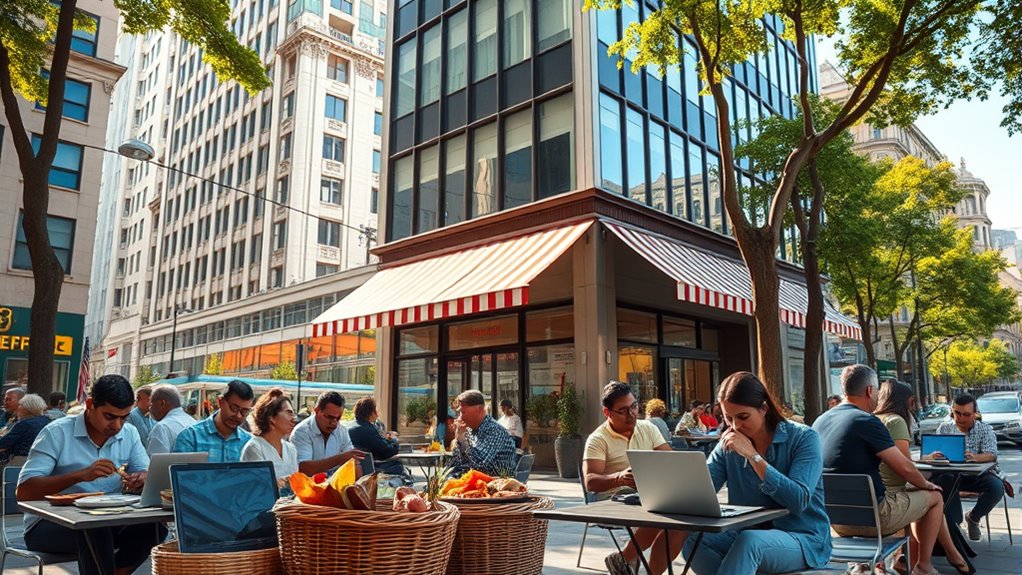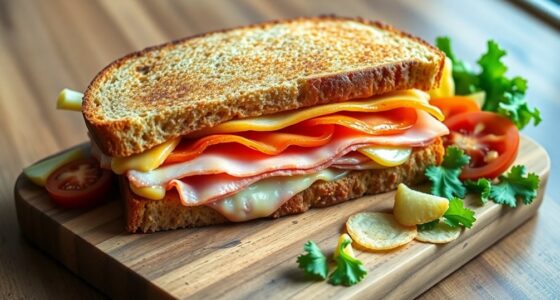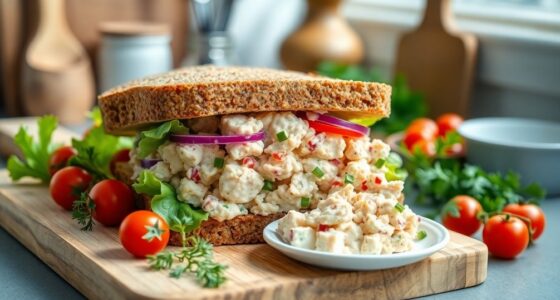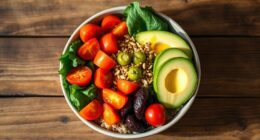The way you take a lunch break has shifted from simple siestas and communal feasts to quick, often individual, desk meals shaped by social, technological, and cultural changes. As lifestyles became busier, people started opting for convenience foods, packed lunches, and delivery options. Modern trends now include diverse cuisines and health-conscious choices, reflecting a faster, more connected world. If you keep exploring, you’ll discover how these shifts continue to influence your lunchtime today.
Key Takeaways
- Lunch originated as simple, practical fare like bread and cheese, serving mainly as a quick refueling during work or chores.
- Over time, lunch evolved into a social and cultural event, incorporating fresh foods and reflecting societal tastes.
- Industrialization shifted lunch from home to structured, hurried meals, with the rise of packed lunches, cafeterias, and fast food.
- Technological advancements, such as delivery apps and microwaves, increased convenience and variety, enabling on-the-go and multitasking meals.
- Modern trends emphasize international cuisines, health-conscious options, and personalization, adapting lunch to faster, connected lifestyles.
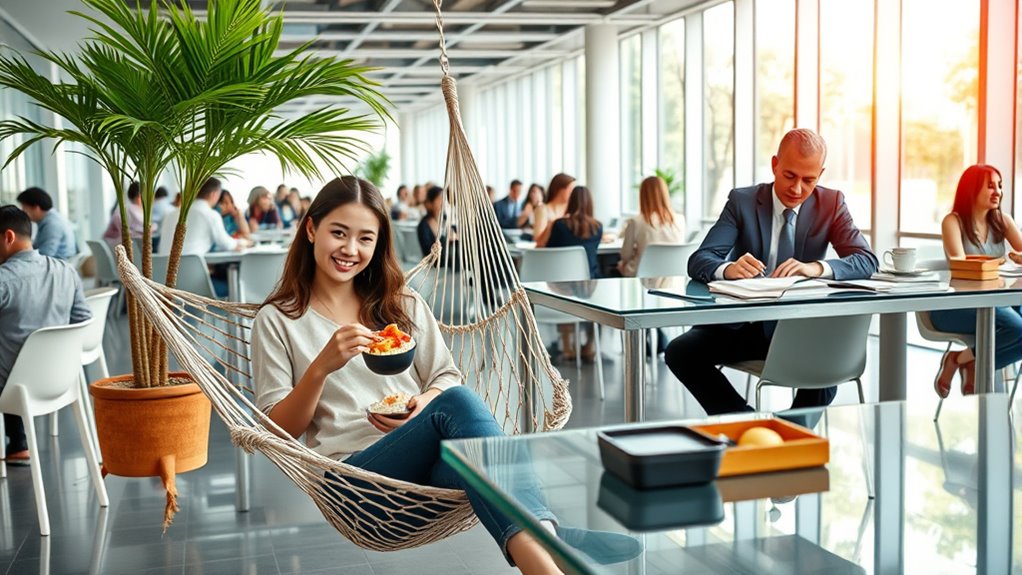
Lunch has come a long way from simple midday meals to a reflection of changing tastes, technology, and lifestyles. In earlier times, it was often a straightforward affair—perhaps a loaf of bread, some cheese, or leftovers from the previous night’s dinner. People took a break from work or daily chores to refuel, but the experience was largely utilitarian.
Lunch started as simple fare—bread, cheese, leftovers—primarily a practical break from daily chores.
As societies evolved, so did the way you approached this midday pause. You might’ve started to enjoy more variety, incorporating fresh fruits, salads, or hot dishes, especially as markets expanded and cooking techniques improved. Lunch became more than just sustenance; it became a social occasion, a time to connect with colleagues or friends over shared plates.
With industrialization came rapid changes. As you entered the workplace, the traditional home-based lunch shifted towards a more structured, often hurried experience. Factory workers and office employees found themselves with limited time, leading to the rise of packed lunches and cafeteria meals.
You might’ve experienced the convenience of pre-made sandwiches, thermos soups, or quick snacks, all designed to fit into tight schedules. This shift was driven by the need for efficiency, but it also introduced new flavors and food options that reflected broader cultural influences. Fast food, for instance, started to appear as a quick, satisfying choice for busy workers.
The advent of technology further transformed how you eat during lunch. Now, you can access a vast array of food options through delivery apps, making it easier than ever to enjoy anything from sushi to burritos without leaving your desk. The rise of microwaves and portable appliances also means you can warm up or prepare meals more conveniently, sustaining the trend of on-the-go dining.
Over time, the notion of what constitutes a ‘proper’ lunch has expanded, incorporating international cuisines and health-conscious choices. You’re no longer limited to traditional sandwiches or salads; instead, you can select meals tailored to your dietary preferences, whether plant-based, gluten-free, or high-protein.
Additionally, understanding the importance of balanced nutrition, many are turning to aromatherapy techniques or products to improve their overall well-being during busy days. Today, lunch is increasingly personalized and adaptable. You might spend your midday break multitasking, catching up on messages, or even working through meetings while munching on a portable snack. The concept of the lunch hour continues to evolve, reflecting how your lifestyle has become faster, more connected, and more diverse.
From leisurely siestas to quick desk dining, the journey highlights how your midday meal mirrors broader societal changes, technology advances, and shifting cultural values.
Frequently Asked Questions
How Did Lunch Customs Vary Across Different Cultures Historically?
You might notice that lunch customs vary widely across cultures. Historically, in Spain, siestas meant a midday break with hearty meals, while in Japan, bento boxes reflect a tradition of carefully prepared, balanced lunches.
In medieval Europe, communal feasts were common among the wealthy. In many cultures, lunchtime was a social event or a quick meal.
These differences highlight how cultural values and daily routines shape lunch habits worldwide.
What Are the Health Impacts of Modern Desk Dining?
You might think eating at your desk boosts productivity, but ironically, it often harms your health. Prolonged sitting, poor posture, and rushed meals can lead to weight gain, digestive issues, and decreased focus.
Instead of multitasking, take a proper break to enjoy your food. Your body and mind will thank you, turning a desk-bound lunch into a moment of genuine refreshment and well-being.
How Have Technology and Apps Changed Lunch Habits?
Technology and apps have transformed your lunch habits by making meal planning and ordering easier. You can now browse menus, customize orders, and get food delivered straight to your desk with just a few taps.
Food tracking apps help you monitor nutrition, while social media keeps you inspired with new ideas. These innovations save time, reduce stress, and encourage healthier choices, making your lunch break more efficient and enjoyable.
What Are Eco-Friendly Practices in Contemporary Lunch?
Did you know that 75% of people now prefer eco-friendly lunch options? You can make a difference by bringing reusable containers, avoiding single-use plastics, and choosing locally sourced, organic foods.
These practices reduce waste and carbon footprints. By making small changes like composting leftovers and supporting sustainable brands, you help protect the environment while enjoying healthier, more conscious meals during your lunch break.
How Do Workplace Policies Influence Lunch Break Durations?
Your workplace policies directly shape your lunch break durations. If policies encourage flexible breaks, you can take longer, more restorative lunches.
Conversely, strict policies or heavy workloads might limit your break time, making it feel rushed or insufficient.
Clear guidelines and supportive management help you prioritize your well-being.
Ultimately, policies that value work-life balance empower you to enjoy your lunch, recharge, and return more focused and productive.
Conclusion
As you embrace the journey from siestas to desk dining, you’re part of a story that echoes through time—like a fleeting shadow of ancient traditions, now reshaped by modern demands. Just as the clock marches on, so does your daily ritual, blending past and present in a dance as old as history itself. So, savor each bite, knowing that every lunch holds a chapter in the ongoing story of how we nourish ourselves amidst life’s constant rhythm.
